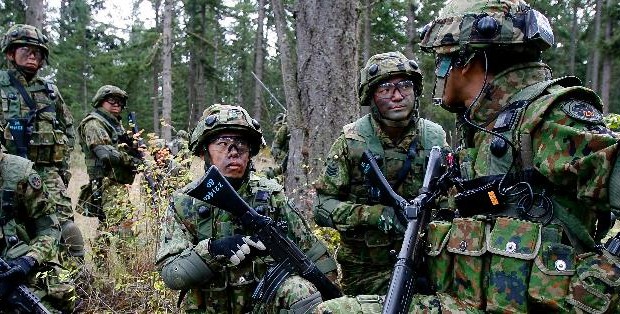By Marc Simms – Junior Fellow
10th July 2014. Security and Defence, Issue 3, No. 3.
Last week, the Japanese cabinet undertook a significant shift in their country’s defence policy, by agreeing to reinterpret the constitutional limits on the use of force in a less strict manner. The new understanding of the restrictions of Article 9 now allow for Japanese “collective self-defense” as well as military intervention to protect its treaty allies.
This represents a significant, if not unexpected departure from the previous interpretation of the Constitution. Previously, it was understood that the Japanese government did not maintain a military, despite the questionable status of the Self-Defence Forces, and did not take part in military operations aside from peacekeeping missions, in a strictly limited fashion.
While a dramatic move and one that is certainly controversial in Japan (and with its various neighbours), this nevertheless fits in with a long-standing process of normalisation or restoration of Japan’s military capabilities. Japan has maintained high defence spending for decades despite the formal limits on expenditure, and the capability of the JSDF Navy in particular outstrips that of several neighbouring states. Last year, Japan considered obtaining a capability to undertake pre-emptive strikes, announced plans to purchase 28 F-35 fighter jets (in addition to the already contracted 48 in 2011), has loosened arms exports and engaged in outreach with local states potentially hostile to China – most notably India.
All of this is no doubt welcome news to the American government. With the “pivot to Asia” firmly focused on containing China’s influence in the Pacific, having a militarily capable Japan which is able to assist the US navy and air-force is no small benefit. Indeed, PM Shinzo Abe seems to be consciously modelling Japanese security strategy on Cheney’s “diamond” quartet, first proposed back in 2007, and under which India, Japan, the USA and Australia would form a democratic counterweight to Chinese power.
Nevertheless, enthusiasm for a larger Japanese role in the security architecture of the Pacific should not preclude worries about the way in which Japan is going about its military restoration, the rhetoric and context in which such an endeavour is taking place.
In particular, there have been two worrying constants in Japanese policy over the last couple of years, in addition to enlarging its military potential, and these are provocation towards China and historical revisionism in regards to WWII.
In declaring a more assertive role over disputed territories, such as the Senkaku Islands, Japan has used the less than diplomatic Chinese reactions to justify their increasing military role and reinforce the perception that Japan sees China as its pre-eminent security threat. This further reinforces Chinese suspicions over Japanese intentions and thus leads to the classic security dilemma territory, where it is all too easy for events to spill out of control due to mutual perceptions of threat. Unfortunately, because Japan’s policy aims are currently reinforced by such behaviour, such provocations likely will not cease any time soon.
This effort is aided by rhetoric and acts from Shinzo Abe in regards to the historical record of the Japanese military in WWII. This rhetoric seems mostly aimed at a domestic audience, using nationalism to protect the government from criticism as it undertakes unpopular economic and military reforms. However, such rhetoric can and appears to be being deployed in the international arena to again provoke undiplomatic responses from China and thus ‘justify’ Japanese security concerns.
While Japan may reap short term gains from such behaviour, in the longer term it will cause other nations in the region to worry about overall Japanese intentions. In particular, South Korea would have a lot to be concerned about, given both the nature of its historical relationship with Japan and its ongoing territorial disputes over the Liancourt Rocks.
A growth in military and political influence could also complicate the Asian pivot, and American attempts to maintain a leadership role among its Asian allies. As Japan’s reliance on American military support becomes less important to its overall security, it would not be unreasonable to see Japan chart a more independent course in the region. And while American and Japanese interests are largely in step in the current international context, this cannot be guaranteed to be the case in the longer term.
In addition to potentially undermining the US pivot, if Japan continues to benefit from an enlarged military and anti-Chinese rhetoric, it may well act as a blueprint for other nations in the region who also have territorial or political disputes with the People’s Republic. Because of the complex history and interaction of states in the region, an overall increase in military spending could contribute to destabilization, deterioration of existing relationships among nations and mutual suspicion – a state of affairs that no-one will profit from.
The biggest problem facing the American strategy in the Pacific will be the temptation towards zero-sum, overly military and security-orientated policies which threaten to exacerbate international tensions. While in the short term, Japanese efforts may appear to be useful towards the end of containing China, in the longer term it has the potential to seriously complicate the situation in that region.
Marc Simms is contactable at:
Marc.Simms@hscentre.org
Please cite this article as:
Simms, M. (2014). ‘Opportunity and Risk in Japan’s military normalisation’
Human Security Centre, Defence and Security, Issue 3, No. 3.
 Human Security Centre Human Rights and International Security Research
Human Security Centre Human Rights and International Security Research




